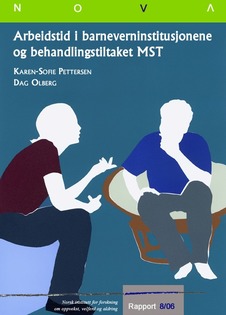| dc.description.abstract | This study was commissioned by the Norwegian Ministry of Children and Equality. It gives an overview of working time arrangements in residential child welfare units and Multisystemic Therapy (MST). Two main research questions are addressed: associations between working time arrangements and treatment outcomes, and between working time arrangements and health and working environment among the employees. A review of relevant literature is included. The study was commissioned because several residential units justify the use of long working shifts with positive treatment outcomes- One the other hand it has been stated that some of these working time arrangements were not in accordance with the provisions in both collective agreements and public working time regulations (Work Environment Act). The data came from a questionnaire, case studies and some interviews. Both leaders and employees were involved in order to gain access to the viewpoints of both positions. Focus group interviews involved five MST-teams in two regions in Southern Norway. In addition two leaders of MST-teams in the Northern region were contacted by phone. Half of the leaders stated that their residential care unit utilizes long working shifts; i.e. being more than 24 hours at work at a time. However, there is great variation where the length of the working periods are concerned, but few units practice very long periods. Most of the units utilize working periods lasting from 24 to 96 consecutive hours. Independently of the length of their working shifts, the employees point out connections between this and therapeutic outcomes. Employees working long shifts or more moderate shifts all argue that their working arrangement facilitates the building of relationships. On their part, employees working ordinary shifts (three per 24 hours) argue that their working arrangement creates continuity over time as well as stability among the staff. The leaders state that positive effects on the health and working environment of the employees are important for their choice of working arrangements. The employees who were interviewed mainly stated that they had good health, but they also pointed out stress factors connected with the working arrangements. The informants who worked the longest shifts told the researchers about little sleep and rest, and few possibilities to compensate for this. More moderate shift arrangements generally led to less tiredness among the employees. Employees working long shifts depended on having sufficient rest during the night to be able to do their work the day after. In a way it is remarkable that employees working the longest shifts to quite a large extent blamed themselves for lack of sleep. Informants working the longest shifts were young, with no children of their own. On the other hand several working moderately long shifts had small children, which influenced the ways these employees combined working hours and leisure hours. While both women and men could see that shift work makes more time together with their own children possible, more men than women seem to think that a working arrangement which includes several days off work also enables them to do things outside the home. The interviews with the MST teams illustrated working arrangements with extraordinarily high availability on the part of the therapists, organised through different shifts or through being available all day and night and all week. Leaders as well as employees justified this with therapeutic concerns. However, the therapists we interviewed did not see this as stressful, as long as they also felt they had large degrees of freedom and flexibility in organizing their own work. They were very sceptical to a development towards increased demands for reports at fixed times, filling in lists of the time used, an in general more written reports. The report discusses how care-workers, for example MST-therapists, handle the tension between thedemandfor their more or less constant availability for the children, and their own need for autonomy at work. Recent changes in the Work Environment Law imply decentralization of working time regulations, with extended possibilities for making local agreements on working time. Such local agreements have to be in accordance with agreement between the collective parties at central level. | en |
